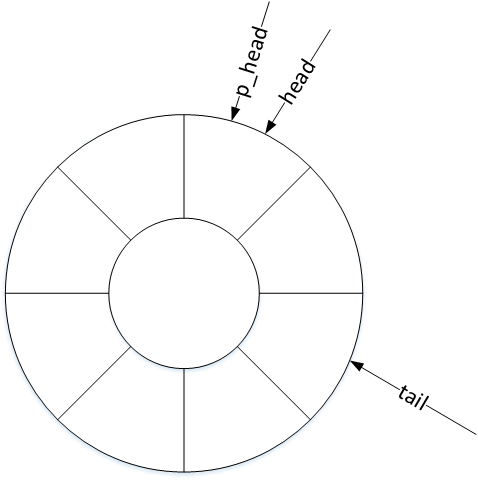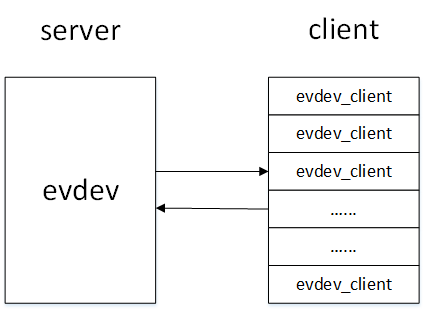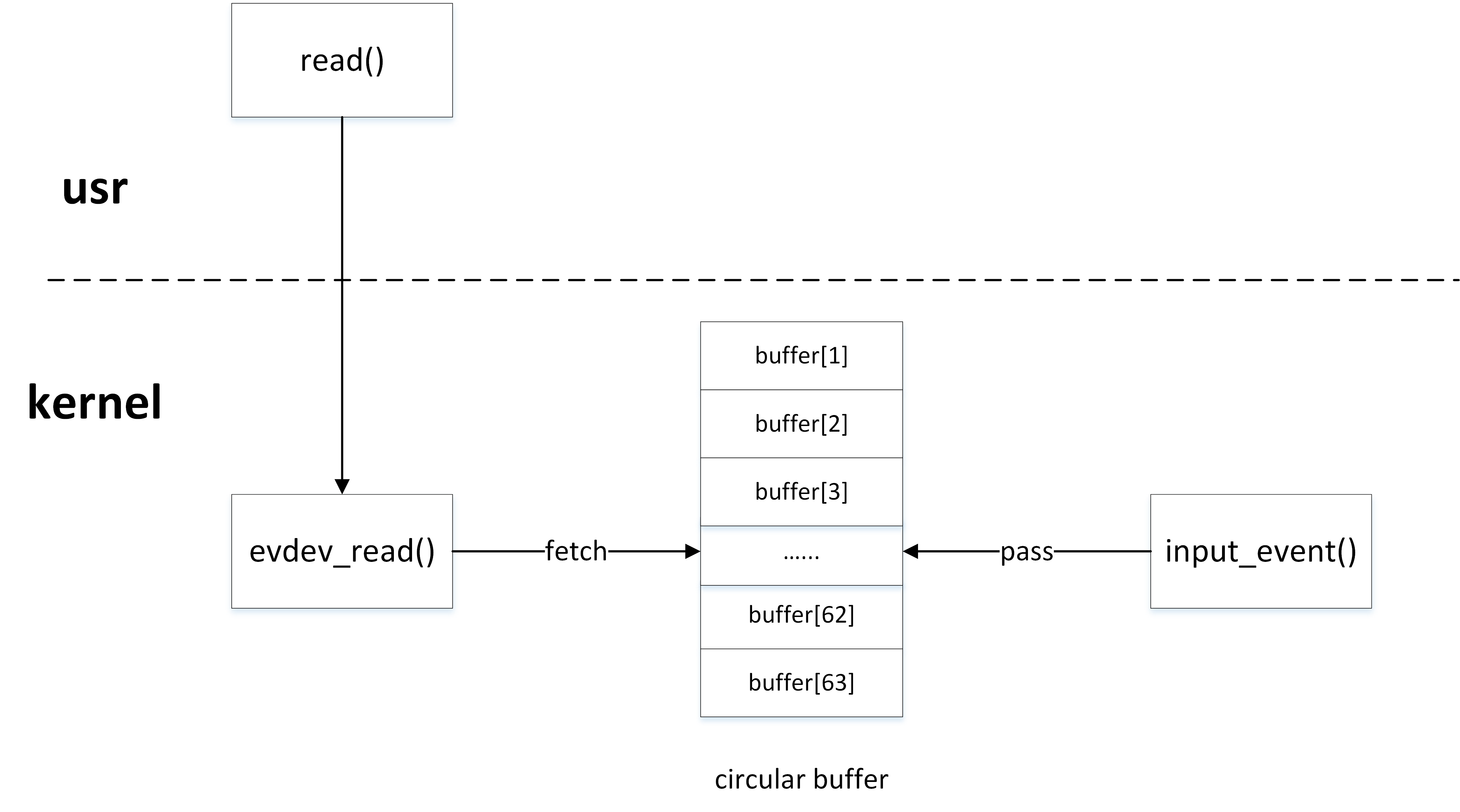input子系统事件处理层(evdev)的环形缓冲区【转】
在事件处理层(evdev.c)中结构体evdev_client定义了一个环形缓冲区(circular buffer),其原理是用数组的方式实现了一个先进先出的循环队列(circular queue),用以缓存内核驱动上报给用户层的input_event事件。
struct evdev_client {
unsigned int head; // 头指针
unsigned int tail; // 尾指针
unsigned int packet_head; // 包指针
spinlock_t buffer_lock;
struct fasync_struct *fasync;
struct evdev *evdev;
struct list_head node;
unsigned int clk_type;
bool revoked;
unsigned long *evmasks[EV_CNT];
unsigned int bufsize; // 循环队列大小
struct input_event buffer[]; // 循环队列数组
};
evdev_client对象维护了三个偏移量:head、tail以及packet_head。head、tail作为循环队列的头尾指针记录入口与出口偏移,那么包指针packet_head有什么作用呢?
packet_head
内核驱动处理一次输入,可能上报一到多个input_event事件,为表示处理完成,会在上报这些input_event事件后再上报一次同步事件。头指针head以input_event事件为单位,记录缓冲区的入口偏移量,而包指针packet_head则以“数据包”(一到多个input_event事件)为单位,记录缓冲区的入口偏移量。

环形缓冲区的工作机制
- 循环队列入队算法:
head++;
head &= bufsize - 1;
- 循环队列出队算法:
tail++;
tail &= bufsize - 1;
- 循环队列已满条件:
head == tail
- 循环队列为空条件:
packet_head == tail
“求余”和“求与”
为解决头尾指针的上溢和下溢现象,使队列的元素空间可重复使用,一般循环队列的出入队算法都采用“求余”操作:
head = (head + 1) % bufsize; // 入队
tail = (tail + 1) % bufsize; // 出队
为避免计算代价高昂的“求余”操作,使内核运作更高效,input子系统的环形缓冲区采用了“求与”算法,这要求bufsize必须为2的幂,在后文中可以看到bufsize的值实际上是为64或者8的n倍,符合“求与”运算的要求。
环形缓冲区的构造以及初始化
用户层通过open()函数打开input设备节点时,调用过程如下:
open() -> sys_open() -> evdev_open()
在evdev_open()函数中完成了对evdev_client对象的构造以及初始化,每一个打开input设备节点的用户都在内核中维护了一个evdev_client对象,这些evdev_client对象通过evdev_attach_client()函数注册在evdev1对象的内核链表上。

接下来我们具体分析evdev_open()函数:
static int evdev_open(struct inode *inode, struct file *file)
{
struct evdev *evdev = container_of(inode->i_cdev, struct evdev, cdev);
// 1.计算环形缓冲区大小bufsize以及evdev_client对象大小size
unsigned int bufsize = evdev_compute_buffer_size(evdev->handle.dev);
unsigned int size = sizeof(struct evdev_client) +
bufsize * sizeof(struct input_event);
struct evdev_client *client;
int error;
// 2. 分配内核空间
client = kzalloc(size, GFP_KERNEL | __GFP_NOWARN);
if (!client)
client = vzalloc(size);
if (!client)
return -ENOMEM;
client->bufsize = bufsize;
spin_lock_init(&client->buffer_lock);
client->evdev = evdev;
// 3. 注册到内核链表
evdev_attach_client(evdev, client);
error = evdev_open_device(evdev);
if (error)
goto err_free_client;
file->private_data = client;
nonseekable_open(inode, file);
return 0;
err_free_client:
evdev_detach_client(evdev, client);
kvfree(client);
return error;
}
在evdev_open()函数中,我们看到了evdev_client对象从构造到注册到内核链表的过程,然而它是在哪里初始化的呢?其实kzalloc()函数在分配空间的同时就通过__GFP_ZERO标志做了初始化:
static inline void *kzalloc(size_t size, gfp_t flags)
{
return kmalloc(size, flags | __GFP_ZERO);
}
生产者/消费者模型
内核驱动与用户程序就是典型的生产者/消费者模型,内核驱动产生input_event事件,然后通过input_event()函数写入环形缓冲区,用户程序通过read()函数从环形缓冲区中获取input_event事件。

环形缓冲区的生产者
内核驱动作为生产者,通过input_event()上报input_event事件时,最终调用___pass_event()函数将事件写入环形缓冲区:
static void __pass_event(struct evdev_client *client,
const struct input_event *event)
{
// 将input_event事件存入缓冲区,队头head自增指向下一个元素空间
client->buffer[client->head++] = *event;
client->head &= client->bufsize - 1;
// 当队头head与队尾tail相等时,说明缓冲区空间已满
if (unlikely(client->head == client->tail)) {
/*
* This effectively "drops" all unconsumed events, leaving
* EV_SYN/SYN_DROPPED plus the newest event in the queue.
*/
client->tail = (client->head - 2) & (client->bufsize - 1);
client->buffer[client->tail].time = event->time;
client->buffer[client->tail].type = EV_SYN;
client->buffer[client->tail].code = SYN_DROPPED;
client->buffer[client->tail].value = 0;
client->packet_head = client->tail;
}
// 当遇到EV_SYN/SYN_REPORT同步事件时,packet_head移动到队头head位置
if (event->type == EV_SYN && event->code == SYN_REPORT) {
client->packet_head = client->head;
kill_fasync(&client->fasync, SIGIO, POLL_IN);
}
}
环形缓冲区的消费者
用户程序作为消费者,通过read()函数读取input设备节点时,最终在内核调用evdev_fetch_next_event()函数从环形缓冲区中读取input_event事件:
static int evdev_fetch_next_event(struct evdev_client *client,
struct input_event *event)
{
int have_event;
spin_lock_irq(&client->buffer_lock);
// 判缓冲区中是否有input_event事件
have_event = client->packet_head != client->tail;
if (have_event) {
// 从缓冲区中读取一次input_event事件,队尾tail自增指向下一个元素空间
*event = client->buffer[client->tail++];
client->tail &= client->bufsize - 1;
if (client->use_wake_lock &&
client->packet_head == client->tail)
wake_unlock(&client->wake_lock);
}
spin_unlock_irq(&client->buffer_lock);
return have_event;
}
input子系统事件处理层(evdev)的环形缓冲区【转】的更多相关文章
- 【Linux高级驱动】input子系统框架
[1.input子系统框架(drivers\input)] 如何得出某个驱动所遵循的框架? 1) 通过网络搜索 2) 自己想办法跟内核代码! 2.1 定位此驱动是属于哪种类 ...
- 【Linux高级驱动】input子系统框架【转】
转自:http://www.cnblogs.com/lcw/p/3802617.html [1.input子系统框架(drivers\input)] 如何得出某个驱动所遵循的框架? 1) 通过网 ...
- 【驱动】input子系统全面分析
初识linux输入子系统 linux输入子系统(linux input subsystem)从上到下由三层实现,分别为:输入子系统事件处理层(EventHandler).输入子系统核心层(InputC ...
- linux输入子系统(6)-input子系统介绍及结构图
注:本系列转自: http://www.ourunix.org/post/290.html input子系统介绍 输入设备(如按键,键盘,触摸屏,鼠标,蜂鸣器等)是典型的字符设备,其一 ...
- input子系统详解
一.初识linux输入子系统 linux输入子系统(linux input subsystem)从上到下由三层实现,分别为:输入子系统事件处理层(EventHandler).输入子系统核心层(Inpu ...
- driver: Linux设备模型之input子系统详解
本节从整体上讲解了输入子系统的框架结构.有助于读者从整体上认识linux的输入子系统.在陷入代码分析的过程中,通过本节的知识能够找准方向,明白原理. 本节重点: 输入子系统的框架结构 各层对应内核中的 ...
- driver: Linux设备模型之input子系统具体解释
本节从总体上解说了输入子系统的框架结构.有助于读者从总体上认识linux的输入子系统.在陷入代码分析的过程中,通过本节的知识可以找准方向,明确原理. 本节重点: 输入子系统的框架结构 各层相应内核中的 ...
- linux kernel input 子系统分析
Linux 内核为了处理各种不同类型的的输入设备 , 比如说鼠标 , 键盘 , 操纵杆 , 触摸屏 , 设计并实现了一个对上层应用统一的试图的抽象层 , 即是Linux 输入子系统 . 输入子系统的层 ...
- Linux Input子系统
先贴代码: //input.c int input_register_handler(struct input_handler *handler) { //此处省略很多代码 list_for_each ...
随机推荐
- 课程三(Structuring Machine Learning Projects),第一周(ML strategy(1)) —— 0.Learning Goals
Learning Goals Understand why Machine Learning strategy is important Apply satisficing and optimizin ...
- IdentityServer4之SSO(基于OAuth2.0、OIDC)单点登录、登出
IdentityServer4之SSO(基于OAuth2.0.OIDC)单点登录.登出 准备 五个Web站点: 1.localhost:5000 : 认证服务器.2 ...
- 【转】使用notepad运行python
Notepad++是一个开源的文本编辑器,功能强大而且使用方便,一般情况下,Notepad++作为代码查看器,很方便,但是每次要运行的时候,总是需要用右键打开其他的IDE来编译和运行,总有些不方便.特 ...
- salesforce lightning零基础学习(十) Aura Js 浅谈三: $A、Action、Util篇
前两篇分别介绍了Component类以及Event类,此篇将会说一下 $A , Action以及 Util. 一. Action Action类通常用于和apex后台交互,设置参数,调用后台以及对结 ...
- transformer 源码
训练时: 1. 输入正确标签一次性解码出来 预测时: 1. 第一次输入1个词,解码出一个词 第二次输入第一次输入的词和第一次解码出来词一起,解码出来第3个词,这样依次解码,解码到最长的长度或者< ...
- WEB安全:Tomcat 只可通过域名访问,禁止通过 IP 访问
服务器为什么要禁止通过IP直接访问? 1.若公布于外网的服务器IP地址未备案,就有可能被工信部查封.这样备案的域名也会无法访问. 2.如果AppScan通过ip访问扫描,会有“发现内部ip泄露模式”的 ...
- Java提高篇之理解java的三大特性——继承
在<Think in java>中有这样一句话:复用代码是Java众多引人注目的功能之一.但要想成为极具革命性的语言,仅仅能够复制代码并对加以改变是不够的,它还必须能够做更多的事情.在这句 ...
- Python和Java编程题(二)
题目:古典问题:有一对兔子,从出生后第3个月起每个月都生一对兔子,小兔子长到第三个月后每个月又生一对兔子,假如兔子都不死,问每个月的兔子总数为多少? 兔子的规律为数列1,1,2,3,5,8,13,21 ...
- nginx作为web服务以及nginx.conf详解
Nginx系列文章:http://www.cnblogs.com/f-ck-need-u/p/7576137.html 1.nginx简介 nginx是一个优秀的web服务程序.反向代理程序.它采用非 ...
- inheritPrototypeChain.js
// 原型链 // 其基本思路是利用原型让一个引用类型继承另一个引用类型的属性和方法 function Person(){ this.name = "Person"; } Pers ...
